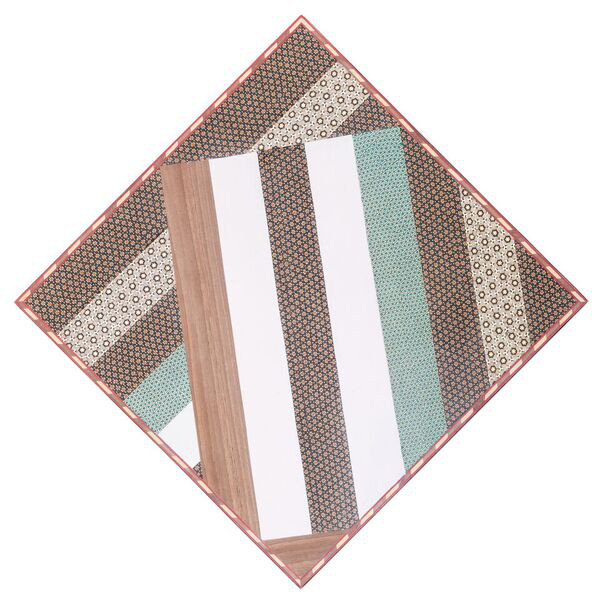
Farhad Ahrarnia is deeply influenced by the craft traditions of his hometown, Shiraz, and uses ancient techniques such as embroidery, metalwork and mosaic to create meticulously crafted works that explore themes of ideological narratives, national identity, and inter-cultural exchange. Another key influence in his art practice is the works of Malevich and other modernist, constructivist artists, which transcend national cultures and identities. By juxtaposing traditional Orientalist craft techniques with materials representing popular culture, Ahrarnia sets up a dialogue between Islamic traditions and Western modernity.
In his latest exhibition at Lawrie Shabibi gallery, Something for the Touts, the Nuns, the Grocery Clerks and You, the British-Iranian artist is presenting new works from his on-going Khatam series, along with a new series comprising discarded cardboard boxes, with gilded illuminations painted on their surfaces. Despite their very different look, each series is about exploring the potential of traditional craft, emphasising its engagement with the modern, and embedding various cultural sensibilities onto seemingly incongruous surfaces.
The show’s title is taken from a seminal poem by German-American writer Charles Bokowski, which is a raw, visceral social commentary on capitalism, power, industrialisation, and consumerism. As part of his own engagement with these issues and his urban environment, Ahrarnia has been collecting discarded packaging boxes from the streets of Shiraz, Kashan and Teheran. For his cardboard series, he dismantled the boxes, leaving the stains, dents, printed and hand written markings on them untouched. He then worked with a Tazhib artist to embellish the rough surfaces with intricate, gilded, decorative concentric patterns that are traditionally used to illuminate valuable, historic religious texts.
By using a simple material associated with manufacturing and consumption, the artist comments on Iran’s historical position as an industrial base, and on the impact of mass-production and consumerism in his country and across the globe. The use of cardboard and the cubic compositions also reference Modernism and Constructivism.
“I am fascinated with cardboard boxes. They are like the skin - of industry and of desire. I love the emptiness of the box after the product is consumed, and the stains and marks absorbed from everyday life on its surface. I chose cartons with ‘Made in Iran’ labels, and texts, symbols and fonts from early 20th century advertising graphics, which were originally influenced by Russian avant-garde. I also looked for products that challenge expectations of what is produced in Iran, as well as iconic products such as kerosene lamps that evoke a sense of nostalgia. Using a traditional high art ornamentation on an incongruous surface seems subversive, but it illustrates how our expressions of modernity can come from tradition. The reference to constructivism also traces how Russian artists, who went to the US influenced the advertising culture there and globally,” he says.
In his Khatam series, the artist has again used an Iranian decorative craft form to explore modernism and constructivism. Khatam is an ancient Iranian micro-mosaic technique used for decorating domestic objects, where thin filaments made from organic materials such as ivory, bone, copper, and brass are methodically grouped together, then cut at the cross section to reveal strips of complex geometric compositions. Ahrarnia’s wall-based mosaics are based on seminal 20th century Modernist and Constructivist paintings and sketches by Max Bill, Lissitzky and Malevich, beautifully combining traditional craft and Islamic abstraction with Western modernism.
The exhibition will run at Lawrie Shabibi gallery, Alserkal Avenue, Al Quoz until March 2.













